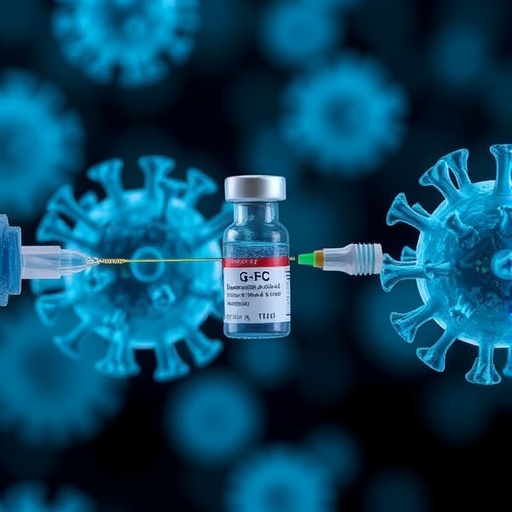
In a significant advancement for infectious disease prevention, researchers have unveiled a novel vaccine candidate targeting herpes zoster, commonly known as shingles, that promises both remarkable immunogenicity and a strong safety profile. Herpes zoster remains a pervasive health challenge, particularly among adults over the age of 50, who face heightened risks of severe complications, including postherpetic neuralgia and other neuropathic pain syndromes. The recently published randomized, active-controlled, non-inferiority trial introduces a recombinant gE-Fc fusion protein subunit vaccine, demonstrating compelling evidence that positions it as a competitive alternative to existing vaccination options. This breakthrough could potentially transform the landscape of shingles prevention and dramatically improve patient outcomes worldwide.
Historically, the prevention of herpes zoster has been centered around live attenuated vaccines and glycoprotein E (gE)-based subunit vaccines. While these vaccines have provided substantial benefits, challenges persist related to immunogenic durability, reactogenicity, and contraindications in immunocompromised cohorts. The innovative approach of this new vaccine harnesses the recombinant fusion of the gE protein with the Fc fragment of human immunoglobulin G (IgG), a design intended to enhance antigen presentation and foster more robust humoral and cellular immune responses. This fusion not only improves the vaccine’s stability and half-life but also optimizes its ability to activate key components of the adaptive immune system, thereby amplifying protective efficacy.
In this large-scale clinical trial employing non-inferiority design parameters, investigators enrolled adults aged 50 years and older, a population historically recognized as vulnerable to herpes zoster due to waning cell-mediated immunity. Participants were randomized to receive either the investigational gE-Fc fusion protein vaccine or an active comparator, traditionally the licensed recombinant subunit vaccine. The trial’s primary endpoints centered around evaluating the magnitude and persistence of gE-specific antibody titers alongside a comprehensive assessment of safety signals. Notably, the immune responses elicited by the gE-Fc fusion protein vaccine were not only non-inferior but in some immunogenic metrics, exhibited superior performance relative to the control.
.adsslot_CxVKP0HWw7{width:728px !important;height:90px !important;}
@media(max-width:1199px){ .adsslot_CxVKP0HWw7{width:468px !important;height:60px !important;}
}
@media(max-width:767px){ .adsslot_CxVKP0HWw7{width:320px !important;height:50px !important;}
}
ADVERTISEMENT
One of the technical marvels underpinning this vaccine’s success lies in the molecular strategy of fusing the gE antigen to the Fc domain of IgG. This fusion leverages the well-characterized Fc receptor-mediated pathways to promote efficient antigen uptake by dendritic cells, the pivotal antigen-presenting cells responsible for priming naïve T cells. By facilitating enhanced endocytosis and subsequent MHC class II presentation, the vaccine effectively stimulates gE-specific CD4+ T cell responses, which are critical for orchestrating both antibody production and cytotoxic T cell activity. This mechanistic insight elucidates why the gE-Fc fusion protein vaccine induces sustained and potent immunological memory.
Safety evaluations were conducted across various demographic subgroups, with investigators closely monitoring the incidence and severity of adverse events. The vaccine exhibited an outstanding safety profile, with local reactogenicity, such as injection site pain and erythema, predominantly mild to moderate and transient. Importantly, systemic adverse events were comparable between the experimental and control groups, reinforcing the vaccine’s suitability for broad use in adults aged 50 and above, including those with comorbidities that often complicate vaccine administration.
From an immunological perspective, the inclusion of the Fc fusion component may also confer additional advantages related to immune complex formation and complement activation. These immune complexes can potentiate antigen processing and provide adjuvant-like effects, further enhancing the magnitude of immune responses beyond what traditional subunit vaccines achieve. Moreover, the recombinant nature of the antigen allows for scalable and consistent manufacturing processes, addressing a critical bottleneck in vaccine production and distribution—a factor highly relevant in global health contexts.
An intriguing aspect of the trial design involved longitudinal follow-up, enabling assessment of immune durability six months post-vaccination. The persistence of high-titer gE-specific antibodies and robust cellular immunity suggests potential for long-lasting protection, which is vital in reducing the incidence of herpes zoster and its debilitating sequelae. These findings also raise the possibility that booster doses might be deferred or even unnecessary for certain cohorts, subject to further longitudinal studies and post-marketing surveillance.
In comparative analyses with existing herpes zoster vaccines, the recombinant gE-Fc fusion protein vaccine demonstrated favorable immunogenic metrics without compromising safety, thus adhering to the strictest regulatory benchmarks for non-inferiority trials. These results are particularly relevant given the growing concern around vaccine hesitancy driven by adverse event fears and public misinformation. The compelling data underscores the vaccine’s potential to achieve high acceptance and uptake among older adults, a demographic critical to controlling herpes zoster burden.
This clinical success has profound implications beyond shingles prevention. The fusion protein platform represents a versatile technology adaptable to other viral pathogens where glycoprotein antigens are prime targets for neutralizing antibodies. Lessons learned from this trial may catalyze development pipelines for subunit vaccines against cytomegalovirus, respiratory syncytial virus, and even emerging pathogens, illustrating the broader translational impact of this research.
Furthermore, the non-inferiority trial design utilized in this study exemplifies a rigorous methodological approach to vaccine evaluation in the post-licensure era. By demonstrating that the new vaccine meets or exceeds the established standards of an effective comparator, the study provides a persuasive case to healthcare providers and policymakers for integrating this innovative option into immunization programs. This step is critical for expanding coverage and tailoring vaccine recommendations based on individual patient risk profiles.
Public health experts have expressed optimism about the potential reductions in healthcare costs and morbidity associated with widespread adoption of the gE-Fc fusion protein vaccine. Herpes zoster and its complications impose significant direct and indirect economic burdens on health systems globally, including prolonged medical treatments, hospitalization, and loss of productivity. A vaccine improving immunogenic consistency and minimizing adverse events could reshape cost-effectiveness models and incentivize early vaccination strategies, especially for aging populations.
The scientific community also lauds this approach for its ability to illuminate fundamental immunological pathways, advancing the understanding of Fc receptor biology and antigen presentation dynamics. These mechanistic insights could inform the rational design of next-generation vaccines, adjuvants, and immunotherapies, fostering innovation that extends well beyond a single disease entity.
Despite these promising outcomes, researchers emphasize the need for ongoing surveillance to monitor real-world effectiveness and rare adverse events that may not emerge in controlled trials. Post-marketing studies and pharmacovigilance will be essential to validate the vaccine’s performance across diverse populations, geographic locations, and clinical contexts. Additionally, future investigations may explore optimized dosing schedules, combination formulations, and co-administration with other vaccines to maximize public health impact.
In summary, the advent of a recombinant gE-Fc fusion protein subunit vaccine for herpes zoster marks a milestone in vaccinology, offering enhanced protection and safety for millions of adults worldwide. This study’s compelling data elucidate critical immunological mechanisms that underpin effective vaccine-induced immunity and chart a path toward wider implementation. As global populations age and demand for safe, efficacious vaccines intensifies, such innovations provide hope for mitigating the burden of herpes zoster and improving quality of life across societies.
Subject of Research: Immunogenicity and safety evaluation of a recombinant gE-Fc fusion protein subunit vaccine for herpes zoster among adults aged 50 and older.
Article Title: Immunogenicity and safety of a recombinant gE-Fc fusion protein subunit vaccine for herpes zoster in adults ≥50 years of age: a randomised, active-controlled, non-inferiority trial.
Article References:
Jin, PF., Quan, YR., Xiu, SX. et al. Immunogenicity and safety of a recombinant gE-Fc fusion protein subunit vaccine for herpes zoster in adults ≥50 years of age: a randomised, active-controlled, non-inferiority trial. Nat Commun 16, 7590 (2025). https://doi.org/10.1038/s41467-025-62800-z
Image Credits: AI Generated
Tags: adult vaccination strategiesgE-Fc subunit vaccinehealth challenges for seniorsherpes zoster preventionimmune response enhancementimmunogenicity and safetyinfectious disease advancementsinnovative vaccine designneuropathic pain syndromespostherpetic neuralgia preventionrecombinant vaccine technologyshingles vaccine development





